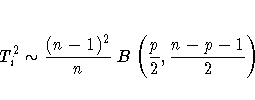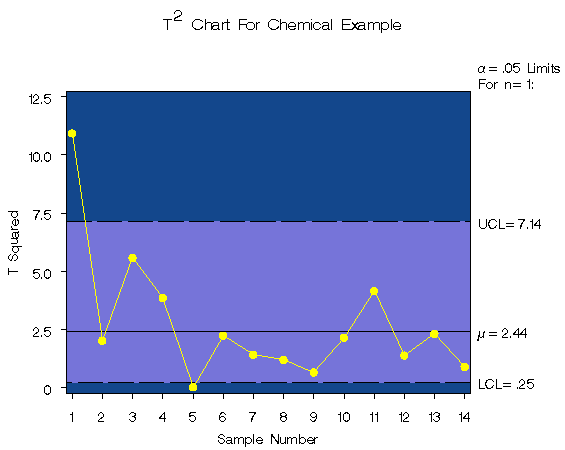Chapter Contents
Previous
Next
|
Chapter Contents |
Previous |
Next |
| Specialized Control Charts |

data startup;
input sample impure temp conc;
label sample = 'Sample Number'
impure = 'Impurities'
temp = 'Temperature'
conc = 'Concentration' ;
datalines;
1 14.92 85.77 42.26
2 16.90 83.77 43.44
3 17.38 84.46 42.74
4 16.90 86.27 43.60
5 16.92 85.23 43.18
6 16.71 83.81 43.72
7 17.07 86.08 43.33
8 16.93 85.85 43.41
9 16.71 85.73 43.28
10 16.88 86.27 42.59
11 16.73 83.46 44.00
12 17.07 85.81 42.78
13 17.60 85.92 43.11
14 16.90 84.23 43.48
;
In preparation for the computation of the control limits,
the sample size is calculated and parameter variables are defined.
proc means data=startup noprint ;
var impure temp conc;
output out=means n=n;
data startup;
if _n_ = 1 then set means;
set startup;
p = 3;
_subn_ = 1;
_limitn_ = 1;
Next, the PRINCOMP procedure is used to compute the principal
components of the variables and save them
in an output data set named PRIN.
proc princomp data=startup out=prin outstat=scores std cov;
var impure temp conc;
run;
The following statements compute T2i and its exact
control limits, using the fact that T2i is the sum
of squares of the principal components.* Note that these statements create
several special SAS variables so that the data set PRIN
can subsequently be read as a TABLE= input data set by
the SHEWHART procedure. These special variables begin
and end with an underscore character.
The data set PRIN is listed in Figure 49.30.
data prin (rename=(tsquare=_subx_));
length _var_ $ 8 ;
drop prin1 prin2 prin3 _type_ _freq_;
set prin;
comp1 = prin1*prin1;
comp2 = prin2*prin2;
comp3 = prin3*prin3;
tsquare = comp1 + comp2 + comp3;
_var_ = 'tsquare';
_alpha_ = 0.05;
_lclx_ = ((n-1)*(n-1)/n)*betainv(_alpha_/2, p/2, (n-p-1)/2);
_mean_ = ((n-1)*(n-1)/n)*betainv(0.5, p/2, (n-p-1)/2);
_uclx_ = ((n-1)*(n-1)/n)*betainv(1-_alpha_/2, p/2, (n-p-1)/2);
label tsquare = 'T Squared'
comp1 = 'Comp 1'
comp2 = 'Comp 2'
comp3 = 'Comp 3';
run;
You can now use the data set PRIN as input to the SHEWHART procedure to create the multivariate control chart displayed in Figure 49.31.
symbol v=dot c=yellow;
title 'T' m=(+0,+0.5) '2'
m=(+0,-0.5) ' Chart For Chemical Example';
proc shewhart table=prin;
xchart tsquare*sample /
xsymbol = mu
cframe = vigb
cinfill = vlib
cconnect = yellow
nolegend ;
run;

|
The methods used in this example easily generalize
to other types of multivariate control charts.
You can create charts using the ![]() and F
distributions by using the appropriate CINV or FINV
function in place of the
BETAINV function in the statements
.
For details, refer to Alt (1985), Jackson (1980, 1991), and Ryan (1989).
and F
distributions by using the appropriate CINV or FINV
function in place of the
BETAINV function in the statements
.
For details, refer to Alt (1985), Jackson (1980, 1991), and Ryan (1989).
|
Chapter Contents |
Previous |
Next |
Top |
Copyright © 1999 by SAS Institute Inc., Cary, NC, USA. All rights reserved.